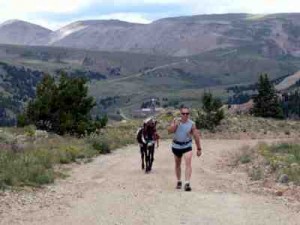Letter from Francisco Armando Rios
Railroads – January 2006 – Colorado Central Magazine
Editors:
At subscription-renewal time, a city feller asks himself: “Why do I want to renew my subscription to Colorado Central? These days I’m more likely to visit Amache, the Beecher Island Battleground, Pawnee Buttes, the site of the Pleasant Hill school bus tragedy, and Picketwire Canyon — a different Colorado, in other words, sometimes far removed from the peaks and passes of Colorado Central country.” Well, the city feller renews his subscription (the check is in the mail) because, after a few intervening decades, he wants to revivify his memories of time spent in Central Colorado — and western Colorado generally.
During the years ’59 to ’62, the GI Bill barely paid the city feller’s tuition at Denver University, so, during a few summers, the city feller worked as third cook on the D&RG. When there were only three cooks on board, the third cook was the dishwasher, and he didn’t do much cooking. But he saw a lot of Colorado, following rivers mainly.
After leaving Pueblo, the third cook rode the galley car northwest and west: Florence, Cañon City, the Royal Gorge, Salida, Buena Vista, Leadville, Tennessee Pass, Minturn, Wolcott, Eagle, Dotsero, Glenwood Canyon, Glenwood Springs, Rifle, Palisade and Grand Junction. What sights the third cook saw, and what memories came of riding those rails!
The train stopped close to Hanging Bridge so that the tourists could clamber down and photograph the walls of the Royal Gorge and the suspension bridge, local wonders. The tourists also photographed the train and crew, local curiosities. The third cook, standing at the galley door in his cap and apron, took a few minutes away from preparations for lunch to pose and smile for the tourists. Luckily, the third cook had no camera. So, instead of small color prints of the Royal Gorge or, later, of the Collegiate Peaks, he has massive, panoramic pictures in his memory. He remembers, too, the small, busy train stations all along the route, and to this day, old train stations are some of his favorite structures.
Some of the third cook’s old search-and-rescue seaplanes of the mid-50s had to struggle to reach 10,000 feet (that’s when he was an aviation radioman in Alaska). And here he was, climbing Tennessee Pass at 10,404 feet in a train. It had to drop sand on the rails to make the grade, but the train did it, and the tourists and the third cook looked way down at old Camp Hale.
The No. 1 train to Grand Junction had no refrigeration, so it took on water and ice periodically. If the milk started to spoil, the waiters poured in a little sugar, stirred the mixture with their fingers, and served it. Compressed logs kept the fires burning and the pots boiling. The third cook kept a wary eye on the pots — only half-filled for safety, but still sloshing boiling water and gravy during those wild rides when the train reached 80 miles per hour on the few straight stretches along the route.
The city feller of today looks back at those environmentally-unfriendly days and cringes when he thinks of how he disposed of trash. Speeds of 80 mph certainly expedited trash disposal. Standing only as close to the galley door as he dared, the third cook tilted the trash cans one after the other at the threshold of the door and consigned mountains of trash to the rushing wind. The railroad owned the right-of-way, said the chef, and it could dispose of trash for miles and miles along the track, if it so wished. Through the agency of the chef, the railroad so wished, and the third cook complied. That’s what he got paid two dollars an hour for. It’s a little late in the day now for apologies, but the city feller – the third cook of forty-five years ago — apologizes to the wondrous lands and rivers of Colorado for his desecration. And the railroad, although no longer in existence, would probably apologize today too.
Let the city feller digress from Central Colorado for a bit and give you another itinerary — this one on a modern train. Still the D&RG of 1960 mind you, but this time to Salt Lake City, via the Moffat Tunnel, Fraser, Tabernash, Granby, Kremmling, Bond, Glenwood Springs, and Grand Junction. It was the businessman’s special, air-conditioned, refrigerated, with a modern galley and dining car. But no thought was given to the beauties of Gore Canyon, which the train traversed at night. The railroad’s objective was to deliver the businessmen to SLC at 8:00 a.m. sharp, which it did, every trip. The third cook missed the splendors of Gore Canyon, but he gained free afternoons, spent in the Mormon Tabernacle, listening to Dr. Schneider perform on that magnificent organ. Then the train deadheaded back to Grand Junction, where it sat and waited in a siding. Sometime, in the hours before dawn, while the third cook slept unawares, the California Zephyr slipped into the yard, coupled the Salt Lake cars to its own, and
Cordially,
The third cook in Central Colorado
Francisco Armando Rios
Denver

